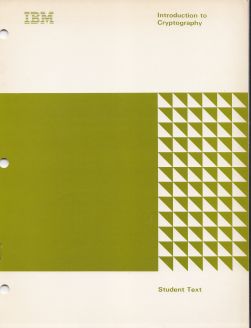 [From IBM's Student Text for Introduction to Cryptography dated
January 1979.]
[From IBM's Student Text for Introduction to Cryptography dated
January 1979.]
The DES Algorithm
During the period from 1968 to 1975, IBM developed a cryptographic algorithm. This algorithm was offered as a candidate for a federal encryption standard. The algorithm, which consists of 16 separate steps, uses a key of 56 bits plus 8 bits of parity. The proposed standard algorithm was originally published in the United States Federal Register, Volume 40, Number 52, dated March 17, 1975.
This algorithm was subjected to extensive analysis by the National Bureau of Standards. On January 15, 1977, the algorithm was adopted as a United States Federal Data Processing Standard, becoming effective on July 15, 1977. The Data Encryption Standard (DES) algorithm is described in detail in the Federal Information Processing Standards Publication #46 dated January 15, 1977 (FIPS PUB46).
[...]
Since the DES standard algorithm is public knowledge with no known "short-cut" solution, deciphering data encrypted using this standard is a matter of obtaining the correct key. But, with 56 bits of user-defined key, there are more than seventy quadrillion possible keys, and therefore someone attempting to decipher the data by testing all possible keys would have to be prepared for a long effort, even using a high-speed computer.
Example of DES Algorithm
Here is an example of data encryption using the DES algorithm. If we assume cleartext of the characters NOW IS THE TIME and a hexadecimal key of:
C1 C2 C4 C8 83 85 86 89
then the resulting encrypted data, also expressed hexadecimally, is:
DA AD 52 AD 3F 3D 07 AC 7C 4A 3C 25 4F 16 21
If we now change the encrypting key to:
C1 C4 C4 C8 83 85 86 89
then the resulting encrypted data is:
9B 58 4E 54 4A 51 2C AD AD D5 64 AC B0 66 F3
Observe how making a very slight change to the encrypting key has a major effect on the encrypted data. This effect is due to the complex nature of the operations performed on the data using the DES algorithm.